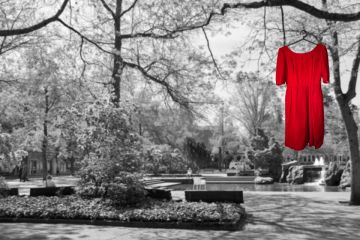Mystery of the Franklin Expedition
- Tara Sharpe

Locating the sunken Erebus has sharpened some of the mystery surrounding the failed expedition-and reinforced Indigenous accounts of the tragedy
The truth is out there, if you know where to look. And now, thanks to the dramatic discovery of the sunken hull of HMS Erebus last fall, clues and questions about the ill-fated Franklin Expedition continue to surface, making this historical mystery as thrilling-and chilling-as any sci-fi TV drama, exactly 170 years after it first piqued people's interest in the 19th century.
"The Franklin Mystery: Life and Death in the Arctic," is the 13th website in the award-winning Great Unsolved Mysteries in Canadian History series, officially launched in Ottawa on June 4. It aims to help crack one of the oldest cold cases of all. Great Unsolved Mysteries, based in the history department at UVic, is built on the premise that everyone loves a mystery and that students of all ages can be drawn into the study of Canadian history with the allure of solving real stories of historical intrigue.
As project co-director and UVic historian Dr. John Lutz says, "History is too important to be boring." And finding one of Franklin's two ships solves one mystery, but opens up many more.
Unsolved questions
The doomed 1845 British mission was the equivalent in its time of sending humans to the moon. But how could 129 men with three years' provisions not survive when local peoples were living off the land? Did lead poisoning, freezing temperatures, conflict or starvation cause the deaths of the crew? Why did the crew abandon HMS Erebus, or did they? What happened to the other ship, HMS Terror, and its crew? Was cannibalism, a part of the Inuit oral testimony, really the unfortunate final chapter in these men's stories?
Research director Lyle Dick, a former president of the Canadian Historical Association who first suggested the 13th mystery to Lutz, explains that the British admiralty's instructions to Sir John Franklin "included as many orders to collect geomagnetic data as they did requests to search for the Northwest Passage. When Franklin's ships became beset in the ice, they were only about 100 miles from the North Magnetic Pole. Were they on a mission to discover not only the Northwest Passage but a kind of early forerunner to the modern Global Positioning System?" Thanks to collaborating historian and author Andrew Lambert, who was interviewed for the Franklin Mystery, this is a new question to be explored on the site.
Dick also points out, "The Franklin Mystery can teach us a great deal about how Aboriginal people have survived in the Arctic over many generations while newcomers didn't because they were not adequately prepared with knowledge and equipment for the rigors of the Arctic environment and climate. The website is unique among Franklin-oriented sites in that it emphasizes the role of Inuit as well as Europeans in this very important chapter in Canadian history."
Toolkit for history sleuths
The Franklin Mystery includes primary historical documents including Inuit testimony, as well as archive photos, paintings, newspaper articles, journal entries, old maps, interactive materials and guides for teachers, and historical interpretations by experts. It features a webquest-style portal with short but powerful lessons for school students to encourage critical thinking about history. There is a detailed history and timeline of the expedition, as well as essays on cultural contexts and current geopolitical issues including climate change and sovereignty.
Also interviewed for the Franklin Mystery was Inuit hunter Louie Kamookak, a historian in Gjoa Haven who was interviewed extensively by various media outlets last fall including by the National Post (with the headline, "The man who pointed the way to the Erebus").
Kamookak, in an interview posted on the Franklin Mystery website, describes his grandmother's story of when she was "maybe about six or seven. They were travelling. The story was that they were on King William Island, they were travelling to the north part of the island to cut some wood and when they got kind of close to the shore there, it was in this area, they came across a ridge . . . and they started finding some artifacts: they didn't know what they were. They were picking up brown things, dark things . . . then she noticed they were from a musket, a rifle. And there were spoons and forks: they didn't know what they were."
He adds, "I always say that if I find Franklin's body, then he should go back to England, to rest beside his wife. That's what his wife wished, for him to be there."
Stewart Arneil of UVic's Humanities Computing and Media Centre coordinated the site's web development.
"The British expedition reflected the technology of its day and now the Franklin Mystery reflects the latest web technology: you can see the evolution of web technology, from our first mystery website to this newest one," adds Merna Forster, executive director of Great Unsolved Mysteries.
Bilingual national teaching project
The Franklin Mystery is available in English and French, with an additional instructional package to be available in Inuktitut.
Launched in 1997 with one website, the bilingual national teaching project now spans almost 1,000 years of history and draws nearly 2,500 users every day from over 50 countries including Morocco, Japan, Israel and Peru.
More than 5,000 teachers and professors have registered to access its guides and lesson plans. The mysteries, ranging from 1000 AD to the 1950s, include numerous unsolved murders as well as the actual location of the first Viking settlement on the East Coast.
Partners and funding
Primary partners with UVic in the Franklin Mystery are the Government of Nunavut Department of Education, Parks Canada, the Library and Archives of Canada and Concordia University.
The 13th mystery project is supported by the Social Sciences and Humanities Research Council through the Partnership Development Grants as part of the series of 13 mysteries, which in total has received over $4 million in financial support from various funding partners including the Department of Canadian Heritage.
The official unveiling in Ottawa on June 4 included an introduction to the Franklin Expedition by Mr. Dick; remarks by Mr. Kamookak on Inuit involvement in the story; and a presentation by Parks Canada archaeologist Marc-Andr&e#180; Bernier. Special entertainment included a musical performance of the Northwest Passage song by Canadian tenor and UVic alumnus Ken Lavigne, as well as Inuit throat singing by the Ottawa Inuit Children's Centre.
Visit the The Franklin Mystery: Life & Death in the Arctic website.
For more information, read the May 25 UVic news release and backgrounder.
Photos
In this story
People: John Lutz







